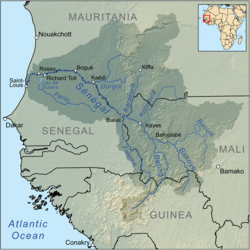Bakoy River
| Bakoy River | |
|---|---|
 | |
| Physical characteristics | |
| Mouth | Sénégal River at Bafoulabé |
• elevation | 83 m |
| Length | 640 km |
| Basin features | |
| River system | Sénégal River |
|
Bakoy River at Oualia, Mali |
|---|
 |
|
Average monthly flow (m3/s) at the Oualia gauging station over the period 1951-1978[1] |
The Bakoy or Bakoye River is a river in West Africa. It runs through Guinea and Mali and joins with the Bafing River to form the Sénégal River at Bafoulabé in the Kayes Region of western Mali. In Manding languages, Bakoye signifies 'white river', Bafing 'black river' and Baloué 'red river'.[2][3]
The source of the Bakoy is at an elevation of 760 m in the granite Monts Ménien to the northwest of Siguiri in Guinea. The river flows north and forms part of the international border between Guinea and Mali. It then meanders across the Mandingue Plateau and joins its principal affluent, the Baloué, which rises to the west of Bamako.[4] The Bakoy drains a basin of 85,600 km2. The river is seasonal with a maximum flow in September after the start of the West African Monsoon and almost no flow between January and June.[1] The average flow at the Oualia gauging station, 54 km upstream of Bafoulabé, is 156 m3/s.[1] At Bafoulabé the average discharge of the Bakoy is between a third and a half of that of the Bafing.[5]
References
- ^ a b c Hydrographic data for Oualia, Mali 1903-1974, Unesco International Hydrological Programme, retrieved 2-Jun-2012
{{citation}}: Check date values in:|accessdate=(help). - ^ Caractéristiques physiques du fleuve Sénégal (in French), Organisation pour la mise en valeur du fleuve Sénégal, retrieved 2 June 2012.
- ^ Maïga, Mahamadou (1995), Le bassin du fleuve Sénégal: de la Traite négrière au développement sous-régional autocentré (in French), L'Harmattan, p. 14 footnotes 4, 5.
- ^ SENEGAL-HYCOS: Renforcement des capacités nationales et régionales d’observation, transmission et traitement de données pour contribuer au développement durable du bassin du Fleuve Sénégal (Document de projet préliminaire) (PDF) (in French), Système Mondial d’Observation du Cycle Hydrologique (WHYCOS), 2007, p. 4.
- ^ Étude des impacts environnementaux du projet d’aménagement de Félou (PDF) (in French), Organisation pour la mise en valeur du fleuve Sénégal, 2006, pp. 59–61.
